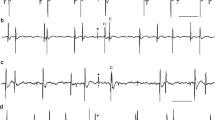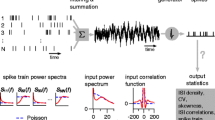Abstract
This paper shows the results of computer simulation of changes in motoneuron (MN) firing evoked by a repetitively applied synaptic volley that consists of a single excitatory postsynaptic potential (EPSP). Spike trains produced by the threshold-crossing MN model were analyzed as experimental results. Various output functions were applied for analysis; the most useful was a peristimulus time histogram, a special modification of a raster plot and a peristimulus time frequencygram (PSTF). It has been shown that all functions complement each other in distinguishing between the genuine results evoked by the excitatory volley and the secondary results of the EPSP-evoked synchronization. The EPSP rising edge was best reproduced by the PSTF. However, whereas the EPSP rise time could be estimated quite accurately, especially for high EPSP amplitudes at high MN firing rates, the EPSP amplitude estimate was also influenced by factors unrelated to the synaptic volley, such as the afterhyperpolarization duration of the MN or the amplitude of synaptic noise, which cannot be directly assessed in human experiments. Thus, the attempts to scale any estimate of the EPSP amplitude in millivolts appear to be useless. The decaying phase of the EPSP cannot be reproduced accurately by any of the functions. For the short EPSPs, it is extinguished by the generation of an action potential and a subsequent decrease in the MN excitability. For longer EPSPs, it is inseparable from the secondary effects of synchronization. Thus, the methods aimed at extracting information about long-lasting and complex postsynaptic potentials from stimulus-correlated MN firing, should be refined, and the theoretical considerations checked in computer simulations.
Similar content being viewed by others
References
Ashby P, Zilm D (1982) Relationship between EPSP shape and cross-correlation profile explored by computer simulation for studies on human motoneurons. Exp Brain Res 47: 33–40
Awiszus F (1988) Continuous functions determined by spike trains of a neuron subject to stimulation. Biol Cybern 58: 321–327
Awiszus F (1997) Spike train analysis. J Neurosci Methods 74: 155–166
Bessou P, Laporte Y, Pages B (1968) Frequencygrams of spindle primary endings elicited by stimulation of static and dynamic fusimotor fibres. J Physiol Lond 196: 47–63
Calvin WH (1974) Three modes of repetitive firing and the role of threshold time course between spikes. Brain Res 69: 341–346
Calvin WH, Schwindt PC (1972) Steps in production of motoneuron spikes during rhythmic firing. J Neurophysiol 35: 297–310
Calvin WH, Stevens CF (1968) Synaptic noise and other sources of randomness in motoneuron interspike intervals. J Neurophysiol 31: 574–587
Cope TC, Fetz EE, Matsumura M (1987) Cross-correlation assessment of synaptic strength of single Ia fibre connections with triceps surae motoneurones in cats. J Physiol Lond 390: 161–188
Eccles JC (1966) The ionic mechanisms of excitatory and inhibitory synaptic action. Ann NY Acad Sci 137: 473–494
Ellaway PH (1978) Cumulative sum technique and its application to the analysis of peristimulus time histograms. Electroencephalogr Clin Neurophysiol 45: 302–304
Fetz EE, Gustafsson B (1983) Relation between shapes of post-synaptic potentials and changes in firing probability of cat motoneurones. J Physiol Lond 341: 387–410
Gerstein GL, Kiang NY (1960) An approach to the quantitative analysis of electrophysiological data from single neurons. Biophys J 1: 15–28
Gustafsson B, McCrea D (1984) Influence of stretch-evoked synaptic potentials on firing probability of cat spinal motoneurones. J Physiol Lond 347: 431–451
Ito M, Oshima T (1965) Electrical behaviour of the motoneurone membrane during intracellularly applied current steps. J Physiol Lond 180: 607–635
Jakubiec M, Piotrkiewicz M (2004) Computer system for analysis of recurrent inhibition between human motoneurons. Biocyber Biomed Eng 24: 3–14
Kernell D (1984) The meaning of discharge rate: excitation-to- frequency transduction as studied in spinal motoneurones. Arch Italy Biol 122: 5–15
Kirkwood PA, Sears TA (1978) The synaptic connexions to intercostal motoneurones as revealed by the average common excitation potential. J Physiol Lond 275: 103–134
Knox CK, Poppele RE (1977) Correlation analysis of stimulus-evoked changes in excitability of spontaneously firing neurons. J Neurophysiol 40: 616–625
Kozhina GV (1983) Study of reflex mechanisms of postinhibitory rebound by means of analysis of single motor unit activity. Neirofiziologiya 15: 78–86
Kudina LP (1976) Effect of tendon reflex on motoneurons of human antagonistic muscle. Neirofiziologiya 8: 624–632
Kudina LP (1988) Excitability of firing motoneurones tested by Ia afferent volleys in human triceps surae. Electroencephalogr Clin Neurophysiol 69: 576–580
Kudina LP (1999) Analysis of firing behaviour of human motoneurones within ‘subprimary range’ J Physiol Paris 93: 115–123
Kudina L, Andreeva R (2005) Discharge frequency and excitability of human firing motoneuron. Biophysics 50: 778–783
Kudina LP, Alexeeva NL (1992) After-potentials and control of repetitive firing in human motoneurones. Electroencephalogr Clin Neurophysiol 85: 345–353
Kudina LP, Pantseva RE (1988) Recurrent inhibition of firing motoneurones in man. Electroencephalogr Clin Neurophysiol 69: 179–185
Levitan H, Segundo J, Moore G, Perkel D (1968) Statistical analysis of membrane potential fluctuations. Relation with presynaptic spike train. Biophys J 8: 1256–1274
MacDonell C, Ivanova T, Garland S (2008) Afterhyperpolarization time-course and minimal discharge rate in low threshold motor units in humans. Exp Brain Res 189: 23–33
MacLean P, Yokota T, Kinnard M (1968) Photically sustained on-responses of units in posterior hippocampal gyrus of awake monkey. J Neurophysiol 31: 1256–1274
Matthews PB (1996) Relationship of firing intervals of human motor units to the trajectory of post-spike after-hyperpolarization and synaptic noise. J Physiol Lond 492: 597–628
Matthews PB (2002) Measurement of excitability of tonically firing neurones tested in a variable-threshold model motoneurone. J Physiol Lond 544: 315–332
Midroni G, Ashby P (1989) How synaptic noise may affect cross- correlations. J Neurosci Methods 27: 1–12
Miles TS (1997) Estimating post-synaptic potentials in tonically discharging human motoneurons. J Neurosci Methods 74: 167–174
Miles TS, Poliakov AV, Nordstrom MA (1995) Responses of human masseter motor units to stretch. J Physiol 483: 251–264
Moore GP, Segundo JP, Perkel DH, Levitan H (1970) Statistical signs of synaptic interaction in neurons. Biophys J 10: 876–900
Nordstrom MA, Fuglevand AJ, Enoka RM (1992) Estimating the strength of common input to human motoneurons from the cross-correlogram. J Physiol Lond 453: 547–574
Person RS, Kudina LP (1972) Discharge frequency and discharge pattern of human motor units during voluntary contraction of muscle. Electroencephalogr Clin Neurophysiol 32: 471–483
Piotrkiewicz M (1999) An influence of afterhyperpolarization on the pattern of motoneuronal rhythmic activity. J Physiol Paris 93: 125–133
Piotrkiewicz M (2000) Modelling of motoneuronal rhythmic activity. Biocyber Biomed Eng 20: 35–43
Piotrkiewicz M (2007) Analysis of factors underlying excitability of human motoneurons by means of computer simulations (in polish). In: XV Conference of Biocybernetics and Biomedical Engineering, Wroclaw
Piotrkiewicz M, Kudina L, Hausmanowa-Petrusewicz I, Zhoukovskaya N, Mierzejewska J (2001) Discharge properties and afterhyperpolarization of human motoneurons. Biocyber Biomed Eng 21: 53–75
Piotrkiewicz M, Kudina L, Mierzejewska J (2004) Recurrent inhibition of human firing motoneurons (experimental and modelling study). Biol Cybern 91: 243–257
Poliakov AV, Miles TS, Nordstrom MA (1994) A new approach to the estimation of post-synaptic potentials in human motoneurones. J Neurosci Methods 53: 143–149
Poliakov AV, Powers RK, Sawczuk A, Binder MD (1996) Effects of background noise on the response of rat and cat motoneurones to excitatory current transients. J Physiol Lond 495: 143–157
Powers RK, Binder MD (1996) Experimental evaluation of input-output models of motoneuron discharge. J Neurophysiol 75: 367–379
Powers RK, Binder MD (2000) Relationship between the time course of the afterhyperpolarization and discharge variability in cat spinal motoneurones. J Physiol Lond 528: 131–150
Schwindt PC, Calvin WH (1973) Nature of conductances underlying rhythmic firing in cat spinal motoneurons. J Neurophysiol 36: 955–973
Stephens JA, Usherwood TP, Garnett R (1976) Technique for studying synaptic connections of single motoneurones in man. Nature 263: 343–344
Tokizane T, Shimazu H (1964) Functional differentiation of human skeletal muscle. Charles C. Thomas, Springfield
Türker KS, Cheng HB (1994) Motor-unit firing frequency can be used for the estimation of synaptic potentials in human motoneurones. J Neurosci Methods 53: 225–234
Türker KS, Powers RK (1999) Effects of large excitatory and inhibitory inputs on motoneuron discharge rate and probability. J Neurophysiol 82: 829–840
Türker KS, Powers RK (2003) Estimation of postsynaptic potentials in rat hypoglossal motoneurones: Insights for human work. J Physiol Lond 551: 419–431
Weber M, Eisen A, Nakajima M (2000) Corticomotoneuronal activity in ALS: Changes in the peristimulus time histogram over time. Clin Neurophysiol 111: 169–177
Zengel JE, Reid SA, Sypert GW, Munson JB (1985) Membrane electrical properties and prediction of motor-unit type of medial gastrocnemius motoneurons in the cat. J Neurophysiol 53: 1323–1344
Zwaagstra B, Kernell D (1980) The duration of after-hyperpolarization in hindlimb alpha motoneurones of different sizes in the cat. Neurosci Lett 19: 303–307
Author information
Authors and Affiliations
Corresponding author
Rights and permissions
About this article
Cite this article
Piotrkiewicz, M., Kudina, L. & Jakubiec, M. Computer simulation study of the relationship between the profile of excitatory postsynaptic potential and stimulus-correlated motoneuron firing. Biol Cybern 100, 215–230 (2009). https://doi.org/10.1007/s00422-009-0293-x
Received:
Accepted:
Published:
Issue Date:
DOI: https://doi.org/10.1007/s00422-009-0293-x




